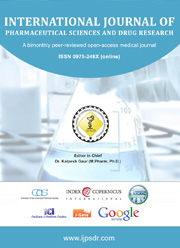Assessing the Effect of Portulaca oleracea Seed Extract for Alleviating Collagen Type-II Induced Arthritis in Female Wistar Rat
DOI:
https://doi.org/10.25004/IJPSDR.2024.160205Keywords:
Rheumatoid arthritis, Collagen Type II, Fish oil, Portulaca oleracea, Arthritis score, Pro-Inflammatory Cytokines, Antioxidant EnzymeAbstract
Rheumatoid arthritis is a sign of progressive degradation of cartilage, subchondral bone, and small joints, as well as the persistence of synovitis and the formation of pannus. This research intends to assess the purported anti-arthritic effects of an extract from the seeds of Portulaca oleracea. Female Wistar albino rats (140–200 g) were used and assigned to five groups: Group I administrated NS (10 ml/kg), Group II received 0.2 ml of CoII-IFA, Group III received 300 mg/kg of fish oil, and Groups IV & V administrated 100 and 200 mg/kg of methanolic extract of Portulaca oleracea (MePO). During the experiment, the rats' weight, arthritic score, and footpad oedema were evaluated to determine the severity of their arthritis. Later, blood samples were collected from the animals, which were then analysed for haematological, pro-inflammatory, antioxidant, and histological parameters. A dose-dependent reduction was seen in rats treated with a methanolic extract of Portulaca seeds. Levels of haematological and pro-inflammatory cytokines were considerably reduced by treatment. Although both the standard drug and 200 mg/kg of MePO had anti-inflammatory effects, the latter's were more pronounced at this dose. When looking at the two side by side, results showed that the treatment groups of RBC, WBC, NL-ratio, and ML-ratio levels were normalised. Further histology confirmed the reduction of joint deformity, oedema, formation of pannus, and infiltration of neutrophils in the MePO groups in contrast to arthritic rats. It is hypothesised that Portulaca oleracea may reduce the arthritis and can be used as an adjuvant therapy or incorporate it into your diet with the main course of treatment.
Downloads
References
Mendoza Vazquez G, Rocha Mu Noz AD, Guerra Soto AJ, Ramirez Villafa Na M, González Sánchez AG, Gamez Nava JI, et al. Arthritis rheumatoid y dyslipidemias. El Residente. 2013; 8:12–22.
Burns CM. Epidemiology of rheumatoid arthritis. In: Longo DL, Kasper DL, Jameson JL et al., editors. Harrison’s principles of internal medicine. 18th ed. The McGraw-Hill Companies 2012.
Henderson B, Pettipher ER, Higgs GA. Mediators of rheumatoid arthritis. Br Med Bull. 1987; 43(2):415–28. Available from: doi.org/ 10.1093/oxfordjournals.bmb.a072191
Snedegard G. Mediators of vascular permeability in inflammation. Prog Apl Microcric. 1985; 7:96–112. Available from: doi.org/10.1159/000411530
Knisella JE, Lokesh B. Dietary lipids, eicosanoids and immune system. Crit Care Med. 1990; 18:S94-113. PMID: 2105185.
Sangeetha S, Kiran RS, Abbulu K, Battu S. A Review on traditional herb Portulaca oleracea. World J. Pharm. Res. 2020; 9:578-601. Available from: doi.org/10.20959/wjpr20203-16924
Kimata M, Cullins DL, Brown ML, Brand DD, Rosloniec EF, Myers LK, et al. Characterization of inhibitory T cells induced by an analog of type II collagen in an HLA-DR1 humanized mouse model of autoimmune arthritis. Arthritis Res Ther. 2012; 14(3):R107. Available from: doi.org/10.1186/ar3832
Trentham DE, Townes AS, Kang AH, David JR. Humoral and cellular sensitivity to collagen in type II collagen-induced arthritis in rats. J Clin Invest. 1978; 61(1):89–96. Available from: doi.org/10.1172/JCI108929.
Zahidah AF, Faizah O, Aqilah KN, Anna KT. Curcumin as an anti-arthritic agent in collagen-induced arthritic Sprague-Dawley rats. Sains Malaysiana. 2012; 41(5):591–5. Corpus ID: 29531821
Estevao Silva CF, Ritter AMV, Ames FQ, Rocha BA da, Comar JF, Wisniewski-Rebecca ES et al. Fish oil as effective supplement preventing inflammatory and histopathological alterations in adjuvant-induced arthritis in rats. Res Soc Dev. 2021; 10(4):e22610414046. Available from: doi.org/10.33448/rsd-v10i4.14046.
Kabir MY et al, Toxicity Studies on the Methanolic Extract of Portulaca oleracea L. (Fam. Portulacaceae). Journal of Biological Sciences. 2007; 7: 1293-1295. Available from: doi.org/10.3923/jbs.2007.1293.1295
Zhang Q, Yu Y, Li J, Guan Y, Huang J, Wang Z, et al. Anti-arthritic activities of ethanol extracts of Circaea mollis Sieb. & Zucc. (whole plant) in rodents. J Ethnopharmacol. 2018; 225:359–66. Available from: doi.org/10.1016/j.jep.2018.04.051.
Shi F, Zhou D, Ji Z, Xu Z, Yang H. Anti-arthritic activity of luteolin in Freund’s complete adjuvant-induced arthritis in rats by suppressing P2X4 pathway. Chem Biol Interact. 2015; 226:82–7. Available from: doi.org/10.1016/j.cbi.2014.10.031
Cui X, Wang R, Bian P, Wu Q, Seshadri VDD, Liu L. Evaluation of antiarthritic activity of nimbolide against Freund’s adjuvant induced arthritis in rats. Artif Cells Nanomed Biotechnol. 2019; 47(1):3391–8. Available from: doi/org/10.1080/21691401.2019.1649269.
Biradar S, Veeresh B. Protective effect of lawsone on L-Arginine induced acute pancreatitis in rats. Indian J Exp Biol. 2013; 15:256–61. PMID: 23678547
Bannatyne G, Wohlmann A. Rheumatoid arthritis: its clinical history, etiology, and pathology. The Lancet. 1896; 147(3791):1120-5.
Cragg GM. Paclitaxel (Taxol): A Success story with valuable lessons for natural products drug discovery and development. Medicinal Research Reviews. 1998; 18:315-331. Available from: doi.org/10.1002/(sici)1098-1128(199809)18:5<315::aid-med3>3.0.co;2-w
Zhang ZC, Zhang SJ, Jin B, Wu Y, Yang XF, Yu B, & Xie QM. Ciclamilast ameliorates adjuvant-induced arthritis in a rat model. BioMed research international. 2015; 786104. Available from: doi.org/10.1155/2015/786104
Rajaram C, Reddy KR, Sekhar KBC. Evaluation of anti-arthritic activity of Caesalpinia pulcherrima in freund’s complete adjuvant induced arthritic rat model. J Young Pharm. 2015; 7(2):128–32. Available from: doi.org/10.5530/jyp.2015.2.12
Nasuti C, Fedeli D, Bordoni L et al. Anti-inflammatory, anti-arthritic and anti-nociceptive activities of Nigella sativa oil in a rat model of arthritis. Antioxidants. 2019; 8(9):342. Available from: doi.org/10.3390/antiox8090342
Mahajan SG, Mehta AA. Anti-arthritic activity of hydroalcoholic extract of flowers of Moringa oleiferalam. In wistar rats. J Herbs Spices Med Plants. 2009; 15(2):149–63. Available from: doi.org/10.1080/10496470903139363
Abu-Hilal M, McPhail MJ, Marchand L, Johnson CD. Malondialdehyde and superoxide dismutase as potential markers of severity in acute pancreatitis. J Pancreas. 2006; 7(2):185–92. PMID: 16525202
Tanwar A, Chawla R, Ansari MM, Neha, Thakur P, Chakotiya AS, et al. In vivo anti-arthritic efficacy of Camellia sinensis (L.) in collagen induced arthritis model. Biomed Pharmacother. 2017; 87:92–101. Available from: doi.org/10.1016/j.biopha.2016.12.089
Downloads
Published
Issue
Section
License
Copyright (c) 2024 Harishankar Gupta; U Rajashekhar, Deepak Kumar Jha

This work is licensed under a Creative Commons Attribution 4.0 International License.


